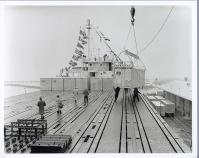
By Roz Hamlett, Editor
Hanging on a wall outside Port Commerce at 4 World Trade Center is an imposing portal to the past: A 14-foot-long board engraved with the name “Gateway City.”
Should you skip reading the exhibit notes beneath the board, you would pass right by this simple installation without ever realizing that the board itself was once the nameplate of one of the first ocean-going container vessels.
The Gateway City was among the famous ships that triggered an economic tsunami in the world of shipping – affecting not only the lives of the barrel-chested men who dominated the waterfront as longshoremen, but economies across the globe.
The story behind the Gateway City and its owner Malcom McLean, the man known in maritime circles as the “father of containerization” is an intricate tale of salty men and big business, unprecedented financial and legal maneuvers, and plot-twisting moments of Aha! flashing like streaks of lightening across McLean’s brilliant mind.
McLean’s breakthrough in containerization signaled the demise of the wharves on the Manhattan waterfront and transformed the Newark/Elizabeth seaport into a premier shipping place for the world’s goods.
Before the SS Ideal X – a refitted tanker ship that was McLean’s first commercial container ship on any waterway – cast off her lines and steamed away from her berth at Port Newark, New Jersey on April 26, 1956, the seaport of Newark previously had been an unprofitable and sleepy dock.
In the run-up years before Ideal X’s maiden voyage, McLean, a self-made trucking magnate from the swampy reaches of southeastern North Carolina, had been scouting out a new terminal site for McLean Trucking.
Meanwhile, the Port of New York Authority had gained control of the seaport of Newark in 1947, and McLean’s timing aligned perfectly with the Port Authority’s growing interest in Newark as a seaport from which to maintain the Port region’s prominence as “the gateway for world commerce.”
The partnership between McLean and the Port Authority was transformative, although McLean himself was not the inventor of the shipping container. Many companies had used metal cargo boxes for decades before the SS Ideal X set sail with 58 steel containers lashed to her topside deck.
McLean was the first to realize that reducing the cost of shipping products required not only a strong metal box, but also an entirely new way of handling freight. His genius lay in his recognition that the shipping industry’s real business was not about sailing ships, but about moving cargo.
In 1956, the cost of loading a ship was $5.86 a ton compared to 16 cents, the cost to load a container onto a ship, which was a 39-fold savings.
Before container shipping, dockworkers loaded individual “break bulk cargo” onto a vehicle from the factory and transported it to a port warehouse, where it was off-loaded and stored to await a vessel.
When the vessel arrived, the goods were moved again, this time alongside the ship to be lowered or carried into the hold of the ship and packed by dock workers.
Containerization greatly reduced the time to load and unload ships. A year after the SS Ideal X sailed, the maiden voyage of McLean’s newly-engineered Gateway City on October 4, 1957 carried 226 fully-loaded containers and featured onboard gantry cranes with a lifting capacity of 60,000 pounds.
Within a few years, containerization revolutionized the shipping industry, triggering a redesign of trucks, ships, rail cars, cranes and other equipment used to transport goods. On August 15, 1962, the Port Authority opened the Elizabeth-Port Authority Marine Terminal, the world’s first all-container port facility, a prototype that prompted other modern ports to copy.
If you want to learn more, we highly recommend “The Box: How the Shipping Container made the World Smaller and the World Economy Bigger,” a definitive work by Marc Levinson on containerization.




